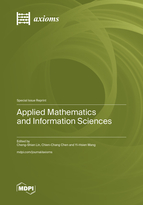Applied Mathematics and Information Sciences
A special issue of Axioms (ISSN 2075-1680). This special issue belongs to the section "Mathematical Analysis".
Deadline for manuscript submissions: closed (20 December 2023) | Viewed by 14941
Special Issue Editors
Interests: image/video processing; image/video forensics; evolutionary algorithms; multimedia content analysis
Interests: image porcessing; watermarking; visual cryptography; evolutionary algorithms; multimedia system
2. Master Program of Business Administration in Practice, Chinese Culture University, Taipei 111, Taiwan
Interests: financial management; applied economics; time series analysis; decision sciences
Special Issues, Collections and Topics in MDPI journals
Special Issue Information
Dear Colleagues,
We are pleased to announce the Special Issue entitled “Applied Mathematics and Information Sciences” to be published in the journal Axioms. Information science has long been a complex and interdisciplinary field. Recent developments in applied mathematics have been employed to construct proper solutions in related fields. In this Special Issue, we deal with research developments in various areas of applied mathematics and/or the application of artificial intelligence, statistical models, etc., to improve the state-of-the-art problems in the information science field. We will welcome and collect theoretical and applied contributions for this Special Issue. Relevant topics include, but are not limited to, the following:
- Intelligent (multimedia) systems;
- Deep learning;
- Evolutionary computing;
- Big data analysis;
- Financial technology;
- Econometric model;
- Quantitative model;
- Business intelligence;
- Decision science analysis.
Dr. Cheng-Shian Lin
Dr. Chien-Chang Chen
Prof. Dr. Yi-Hsien Wang
Guest Editors
Manuscript Submission Information
Manuscripts should be submitted online at www.mdpi.com by registering and logging in to this website. Once you are registered, click here to go to the submission form. Manuscripts can be submitted until the deadline. All submissions that pass pre-check are peer-reviewed. Accepted papers will be published continuously in the journal (as soon as accepted) and will be listed together on the special issue website. Research articles, review articles as well as short communications are invited. For planned papers, a title and short abstract (about 100 words) can be sent to the Editorial Office for announcement on this website.
Submitted manuscripts should not have been published previously, nor be under consideration for publication elsewhere (except conference proceedings papers). All manuscripts are thoroughly refereed through a single-blind peer-review process. A guide for authors and other relevant information for submission of manuscripts is available on the Instructions for Authors page. Axioms is an international peer-reviewed open access monthly journal published by MDPI.
Please visit the Instructions for Authors page before submitting a manuscript. The Article Processing Charge (APC) for publication in this open access journal is 2400 CHF (Swiss Francs). Submitted papers should be well formatted and use good English. Authors may use MDPI's English editing service prior to publication or during author revisions.
Keywords
- intelligent (multimedia) systems
- deep learning
- evolutionary computing
- big data analysis
- financial technology
- econometric model
- quantitative model
- business intelligence
- decision science analysis.





